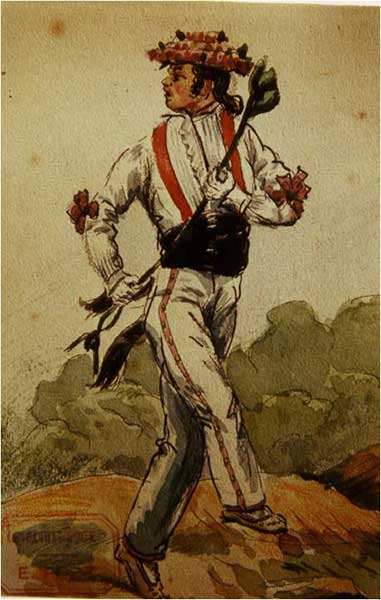
In the province of Labourd, which takes its name from both Lapurdum, the station of the Roman cohort located on the site of the upper town of Bayonne, and the Viscounty of Labourd in the county of Gascony, which was erected at the beginning of the 11th century, the earliest carnivals begin in late January or early February. In each village a group organizes itself, visiting all the farms, houses and neighbourhoods of the village during carnival time, in some villages the tour can be spread over two, three or four weekends.
The kaskarot and the carnival
The kaskarot are the main characters of the Labourdin carnivals. They wear hats decorated with flowers, ribbons and colourful decorations on their costumes, and hold two sticks in their hands.
Organized in groups of eight, they perform makila-dantza (stick dances), as well as dance jumps, marmutx (small stick dance), xinple, kontra-dantza (contradance), soka-dantza, fandango and arin-arin.
Alongside the dancers, both boys and girls, are the flag-bearer groups, besta-gorriak (the red jackets), ponpierrak, kotilun-gorriak (the red petticoats), jaun-andereak (the men and women), the bear and, depending on the village, other characters.
It is in Abaltzisketa, in Guipuzcoa, that one finds a carnival very close to the kaskarot of Labourd. Eight dancers, adorned with colourful scarves, perform the makila-dantza (the dance of the sticks) as they search from farm to farm. It is the txantxoak who, accompanied by an accordionist, perform the dance of the sticks. The troupe that marches here is more sober, and two other types of characters intervene alongside the txantxoak. Before dancing with a broom in his hand, one of them cleans the threshold of the farmhouse and the second, the basket maker, collects the food offered by the farm's inhabitants. The talai-dantza (vigil dance) of the Amezketa dancers is practically the same as that of the txantxoak, but performed with more liveliness.
On the very border of Guipuzcoa and Bizkaia, in Markina-Xemein, there is another group of makila-dantza dancers on Carnival Sunday. They perform the zahagi-dantza (the dance of the other side) and they complete the show with the bear dance.
With Basque Country 1900
Translated with www.DeepL.com/Translator
(free version)




